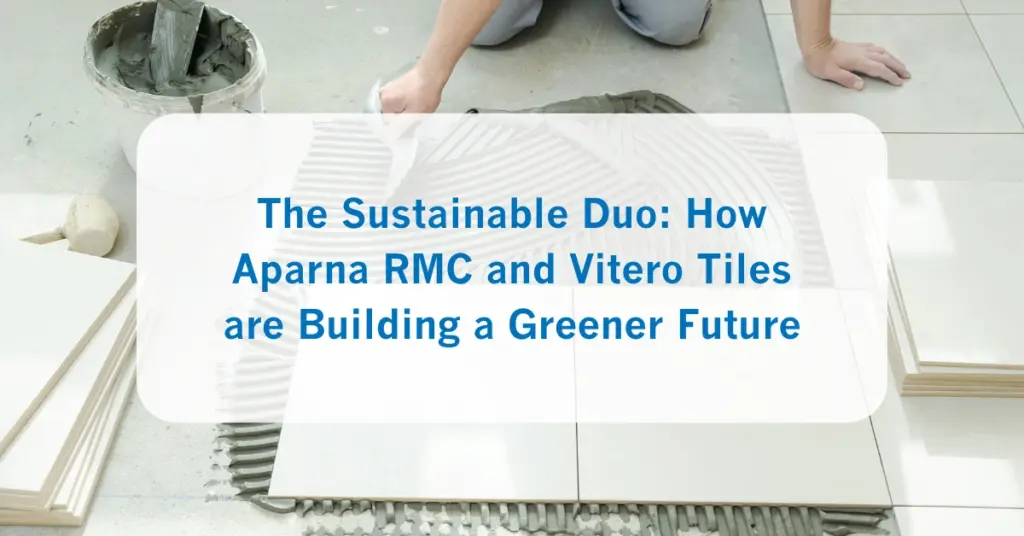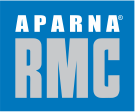The Sustainable Duo: How Aparna RMC and Vitero Tiles are Building a Greener Future

November 25, 2025
1. Introduction
The global construction industry is undergoing a massive transformation — one that prioritizes sustainability alongside strength and aesthetics. In India, where urbanization is accelerating faster than ever, the demand for eco-friendly building materials has never been higher.
Two names have consistently set benchmarks in this green revolution: Aparna RMC and Vitero Tiles. Together, they represent the new face of responsible construction — where durability meets design, and innovation meets environmental care.
This blog explores how these two industry leaders are not only shaping skylines but also protecting the planet through their sustainable practices, materials, and manufacturing processes.
2. The Sustainability Imperative in Modern Construction
Today’s builders and architects are redefining what it means to build responsibly. It’s no longer just about cost and speed — it’s about the carbon footprint, energy efficiency, and life-cycle performance of every material used.
According to the United Nations Environment Programme (UNEP), buildings and construction are responsible for nearly 40% of global CO₂ emissions. This reality has made sustainability not just a choice but a necessity.
Here’s where Aparna RMC and Vitero Tiles stand out — by embedding sustainability into every stage of their production and product lifecycle.
3. Aparna RMC: The Foundation of Green Building
a. Eco-Friendly Raw Materials
Aparna RMC leads the shift toward low-carbon concrete by incorporating sustainable materials such as:
- GGBS (Ground Granulated Blast Furnace Slag) – reduces the need for cement, lowering CO₂ emissions.
- Fly Ash – a by-product of thermal plants, reused to create high-strength, eco-friendly mixes.
- M-Sand (Manufactured Sand) – replaces river sand, protecting natural resources.
These materials not only minimize environmental harm but also enhance concrete strength and durability.
b. Smart Production Practices
Every Aparna RMC plant operates on SCADA-controlled batching technology, ensuring zero waste, accurate proportioning, and reduced energy consumption.
By adopting closed-loop water recycling and dust collection systems, Aparna minimizes industrial waste and air pollution — proving that industrial-scale production can still be sustainable.
c. Supporting Green Building Certifications
Aparna RMC’s eco-friendly mixes are widely used in IGBC and GRIHA-certified projects, helping developers achieve higher sustainability ratings without compromising on performance.
Key advantage: Aparna’s concrete mixes can reduce embodied carbon by up to 20% compared to conventional site-mixed concrete.
4. Vitero Tiles: Sustainability with Style
a. Low-Impact Manufacturing Process
Vitero Tiles are produced using state-of-the-art Italian technology that emphasizes efficiency at every stage.
From raw material selection to kiln firing, the entire process is optimized to reduce energy usage and lower emissions.
How Vitero ensures sustainable production:
- Uses energy-efficient kilns to cut fuel consumption.
- Implements zero-waste water recycling systems.
- Reuses process waste and broken tiles in manufacturing.
The result? Tiles that are not only beautiful but also built with respect for the environment.
b. Eco-Friendly Materials and Finishes
Each Vitero tile is crafted using responsibly sourced materials and low-VOC glazes, ensuring healthier indoor air quality.
The company’s nano-polish and digital printing technologies also use fewer chemicals and pigments, reducing environmental impact.
Bonus: Vitero’s vitrified tiles are long-lasting and low maintenance, which means fewer replacements — and less waste in the long run.
c. Promoting Green Interiors
Sustainability isn’t just about how something is made — it’s also about how it performs.
Vitero Tiles offer several environmental performance benefits, including:
- High solar reflectance, reducing indoor heat absorption.
- Low water absorption, extending tile lifespan.
- Slip-resistant textures, promoting safety in public and residential spaces.
Together, these features make Vitero Tiles an essential part of eco-friendly architecture.
5. Building a Greener Future Together
The collaboration between Aparna RMC and Vitero Tiles demonstrates how sustainability can be achieved through vertical integration — controlling quality and responsibility from foundation to finish.
a. Reduced Carbon Footprint Across the Chain
- Aparna RMC lowers embodied carbon at the structural level.
- Vitero Tiles maintain energy efficiency at the aesthetic level.
- Together, they reduce environmental impact across the entire building life cycle.
b. End-to-End Sustainable Ecosystem
By combining concrete and tile solutions under one brand family, Aparna Group ensures a streamlined, sustainable supply chain — from raw material sourcing to delivery and installation.
c. Driving India’s Green Building Movement
With the growing adoption of IGBC-certified projects, Aparna Group plays a critical role in helping developers meet sustainability targets while maintaining cost efficiency and aesthetic appeal.
6. Checklist: Why Choose Aparna RMC and Vitero Tiles for Sustainable Construction
✅ Looking to reduce your project’s carbon footprint?
✅ Need eco-friendly materials that meet IGBC or GRIHA standards?
✅ Want durable, long-lasting products that reduce maintenance and replacement costs?
✅ Prefer working with a single integrated supplier for both concrete and tiles?
If you answered yes, Aparna RMC and Vitero Tiles are your go-to partners for sustainable, future-ready construction.
7. How Aparna Group Sets the Standard
Innovation with Responsibility:
Aparna Group constantly invests in R&D to create new mixes, finishes, and manufacturing methods that lower environmental impact.
Proven Expertise:
With decades of experience in concrete and tile manufacturing, Aparna delivers solutions trusted by engineers, architects, and builders across India.
Nationwide Presence:
From Hyderabad and Bengaluru to Mumbai and Chennai, Aparna’s 36+ RMC plants and widespread Vitero dealer network ensure green materials are always within reach.
Landmark Contributions:
Aparna products have contributed to India’s most sustainable infrastructures — from metro projects to smart cities and energy-efficient housing developments.
8. Conclusion
Sustainability isn’t a trend — it’s the foundation of tomorrow’s construction industry. As India moves toward greener and smarter infrastructure, the partnership between Aparna RMC and Vitero Tiles stands as a benchmark in eco-friendly innovation.
From low-carbon concrete to energy-efficient tiles, these two brands are redefining how structures are built — stronger, cleaner, and more beautiful.
👉 Build responsibly. Choose Aparna RMC and Vitero Tiles — where every product supports your sustainability goals without compromising on performance or design.
9. FAQs
Q1: What makes Aparna RMC and Vitero Tiles sustainable?
Both brands use eco-friendly raw materials, energy-efficient production systems, and water recycling to minimize environmental impact.
Q2: Are these materials suitable for green building certifications?
Yes, both products support IGBC and GRIHA-certified projects through sustainable design and reduced carbon output.
Q3: Can sustainable materials also be stylish and durable?
Absolutely. Vitero Tiles combine elegant designs with long-lasting strength, while Aparna RMC provides structural reliability with environmental consciousness.
